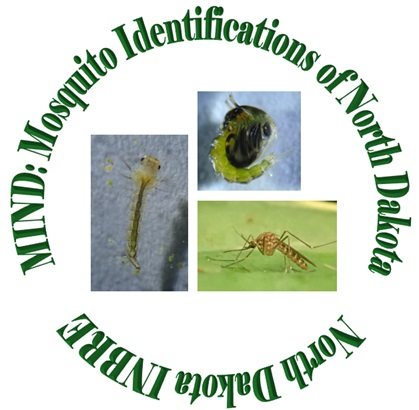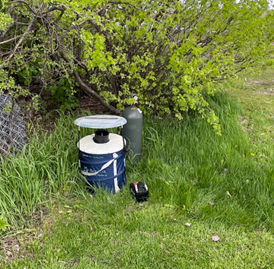


Mosquitoes play an important role within the state of North Dakota. Mosquitoes can transmit numerous pathogens and viruses to humans, wildlife, and livestock. It is important to recognize that not all mosquito species can transmit all parasites or viruses. In addition, mosquitoes are integral to food webs that support amphibian, fish, and avian populations.
One of the best methods of disease prevention is education which includes, at the foundational level, knowing which mosquito species are found in an ecosystem (and across the state). Not only is it important to know what species are present, but also when each species is out during the summer and how many mosquitoes are present. An example of when/and to what extent mosquito numbers play a role is evident when investigating the cases of West Nile virus across our state…typically late July-September when Culex tarsalis populations are at their highest.
Our goal is to recognize mosquito populations across the state of North Dakota by collecting, identifying, and monitoring population trends of mosquitoes throughout the summer months. In addition, mosquitoes that are engorged (contain blood), can be used to identify what the different mosquito species tend to feed upon (host preference). As data is collected, the project will also analyze how weather and climate data can influence mosquito populations.
This site will provide information from this project to the public and to other fellow mosquito enthusiasts who may be interested in what mosquitoes are doing in the highly under-researched state of North Dakota. Support for this project comes from ND INBRE. Students and faculty present information collected from this project at the annual ND INBRE conference, regional conferences, national meetings, and at other professional organizations such as the Entomological Society of America conferences.

Common Name - Colorado Plume Moth
Phylum: Arthropoda
Class: Insecta
Order: Lepidoptera
Family: Pterophoridae
Stenoptilia coloradensis, commonly known as the Colorado plume moth, is a member of the family Pterophoridae and is found across various regions of North America, including parts of Canada and the United States. While specific records in North Dakota are limited, its known range—which includes nearby states and provinces such as Colorado, Ohio, and Alberta—suggests it may occur in suitable habitats within North Dakota as well.
Ecologically, this moth is associated with open habitats where its larval host plant, Gentiana quinquefolia (commonly known as agueweed), is present. This plant is native to eastern North America and can be found in moist meadows and prairies, which are characteristic of parts of North Dakota. The larvae feed exclusively on this plant, making its distribution a key factor in the moth’s presence.
The lifecycle of S. coloradensis follows a holometabolous development pattern, meaning it undergoes complete metamorphosis with four distinct stages: egg, larva, pupa, and adult. The larvae possess biting-chewing mouthparts adapted for feeding on the leaves of Gentiana quinquefolia. After feeding and growth, the larvae pupate, eventually emerging as adults with a wingspan ranging from 16 to 24 mm. Adults are characterized by their slender, plume-like wings, which are divided into lobes and fringed with fine scales, aiding in camouflage among grasses and low vegetation.
In North Dakota, the moth’s activity would likely peak during the warmer months, aligning with the growth period of its host plant. Its presence contributes to the local biodiversity and serves as a specialized herbivore within prairie ecosystems.
This project utilizes a few different mosquito collection methods including the following trap types that are typically associated with mosquito research.


